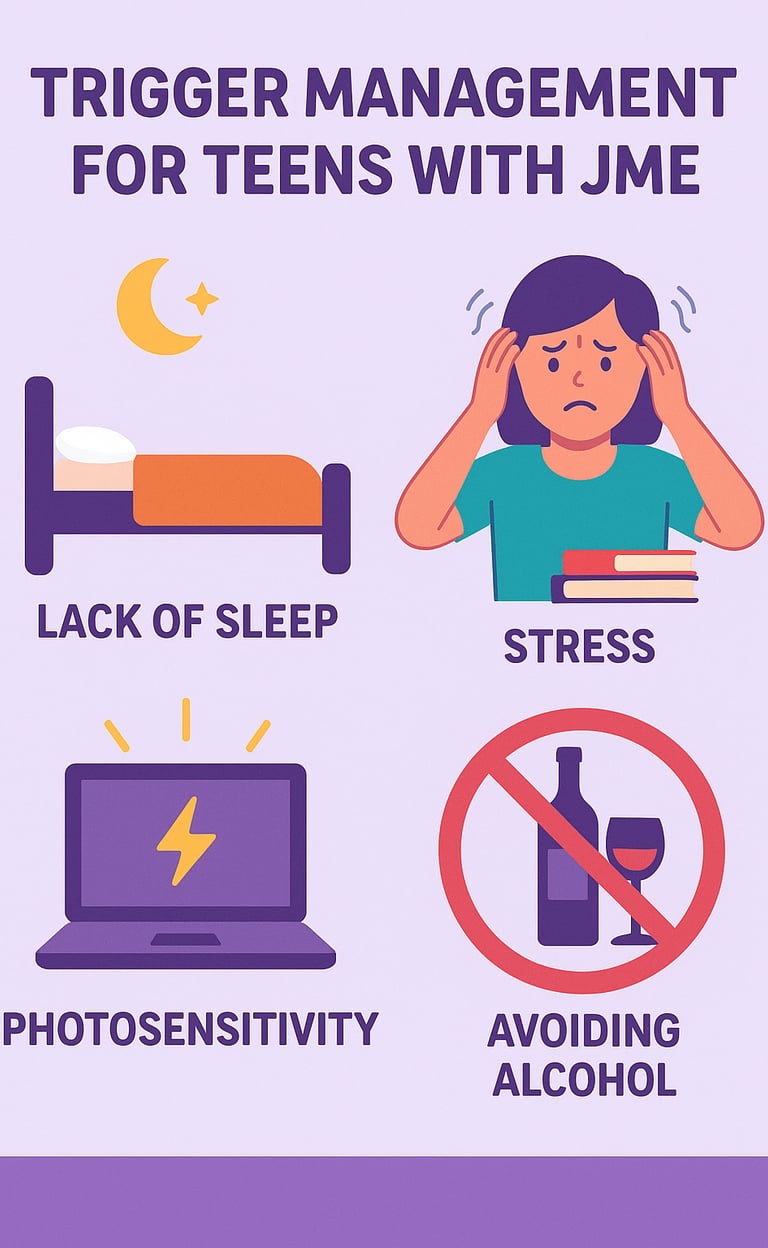Understanding Juvenile Myoclonic Epilepsy (Janz Syndrome)
Juvenile Myoclonic Epilepsy (JME) is one of the most common, yet misunderstood forms of generalized epilepsy. In this in-depth, easy-to-understand guide, we break down what families need to know about JME, from early signs like morning myoclonic jerks to major triggers such as sleep loss and stress. Through the relatable story of Chichi, a vibrant teen navigating sudden seizures and newfound challenges, this blog post brings clinical facts to life and shows that JME is both manageable and hopeful. You’ll learn about diagnosis, seizure types, treatment options, lifestyle strategies, long-term outlook, and how real-world habits can transform outcomes. Whether you're a parent, caregiver, educator, or someone living with JME, this post offers clarity, compassion, and practical guidance, helping you understand the condition and confidently move forward.
Dr. Clotilda Chinyanya
11/20/20255 min read


Juvenile Myoclonic Epilepsy (JME), also called “Janz syndrome,” is one of the most common types of generalized epilepsy. It accounts for up to 10% of all epilepsies, yet many families have never heard of it until a child, teenager, or young adult suddenly begins experiencing myoclonic jerks, morning seizures, or strange “blanking-out” spells. This guide brings together current research, clinical expertise, and lived experience, illustrated through the story of Chichi, a bright and energetic teen whose journey with JME will feel familiar to many families.
Meet Chichi: A Story to Understand JME
Fifteen-year-old Chichi was known for her early morning routine. Every day, before school, she made hot cocoa, packed her backpack, and practiced a few minutes of her favorite dance choreography. But over a few weeks, something strange began happening.
· One morning, as she lifted her cup of cocoa, her arm jerked abruptly. The drink splashed across the counter.
· Then her toothbrush jumped out of her hand.
· The next day, her phone slipped from her grip and cracked.
At first, Chichi shrugged it off. Maybe she was tired. Maybe she wasn't paying attention. But the jerks kept happening, always within an hour of waking up.
Then one Saturday morning, just as she was heading to the kitchen, she felt a cluster of sharp jolts run through both arms. Before she could call out, everything went black. She had a generalized tonic–clonic seizure, her first ever. Her parents rushed her to the emergency room.
The doctor asked detailed questions about her mornings, her sleep habits, and her stress at school. Chichi admitted she had been staying up past midnight watching movies, waking early to study for exams, and skipping breakfast. “Just normal school stuff,” she said quietly.
The neurologist nodded.
He ordered an EEG. The results showed a classic pattern for JME: generalized spike-and-wave and polyspike-wave discharges, especially triggered by flashing light during the test.
“Chichi,” he said gently, “you have a type of epilepsy called Juvenile Myoclonic Epilepsy. The good news? With lifestyle adjustments and the right treatment, most people live full, normal lives.”
Chichi was scared, but also relieved. For weeks she had felt clumsy, tired, and confused. Now she finally had answers. And with guidance on sleep, screens, medication, and stress management, her jerks began to fade and her confidence returned.
Her story mirrors what thousands experience: JME is sudden, confusing, and frightening at first, but with knowledge and support, life truly moves forward.
What Exactly Is Juvenile Myoclonic Epilepsy?
Juvenile Myoclonic Epilepsy is a genetically influenced generalized epilepsy syndrome. It typically begins between ages 10 and 24, though onset may range from 6 to 40 years.
It affects males and females equally, though some studies note a slight female predominance.
People with JME usually:
✅ Have normal early development
✅ Have normal intelligence overall (though subtle challenges with attention, impulse control, or executive function can appear)
✅ Have normal neurological exams and brain imaging
Up to 60% of families report a history of seizures in a relative, but no single gene explains all cases. JME likely results from a combination of genetic factors.
The Three Types of Seizures Seen in JME
Myoclonic Seizures (Mandatory for Diagnosis)
These are the hallmark of JME. Everyone with JME has them.
They appear as:
Sudden, shock-like jerks of the arms or fingers
Dropping objects
Jerks that occur 1–2 hours after waking
Jerks triggered by sleep deprivation, stress, or flashing lights
About 20% of people may have jerks more prominent on one side of the body.
These are often the first symptom families notice, even though many shrug them off as clumsiness, as Chichi did.
Generalized Tonic–Clonic Seizures
Up to 90–100% of people with JME will eventually have at least one.
Features:
Often occur in the morning
Sometimes follow a cluster of myoclonic jerks
Triggered by sleep loss, alcohol, or emotional stress
These seizures are often what bring someone to medical attention.
Absence Seizures
These occur in less than half of people with JME.
Features:
Short (usually <10 seconds)
May not fully impair awareness
More subtle than absences seen in childhood absence epilepsy
Absence seizures, when present, are important because research shows they can predict a higher chance of resistance to medication.
What Triggers Seizures in JME?
Two major triggers stand out:
✅ Lack of Sleep
This is the most powerful. Missing sleep can cause:
More morning jerks
Myoclonic status (continuous jerks)
Generalized seizures
Teens who already struggle with sleep are especially vulnerable.
✅ Stress
Emotional stress, academic pressure, excitement, and frustration all increase seizure likelihood.
✅ Photosensitivity
Up to 90% of people in some cohorts show photosensitivity on EEG.
Common triggers include:
Strobe lights
Video games
Flashing sunlight through trees
Flickering TV or phone screens
Interestingly, photosensitivity in girls correlates with lower odds of medication resistance, according to recent prognostic research.
Diagnosis of JME
JME is diagnosed through a combination of:
Clinical history
Description of myoclonic jerks
Seizure timing (especially mornings)
Triggers
Sleep habits
Family history
EEG
The most important diagnostic tool.
Typical findings:
3–6 Hz generalized polyspike-and-wave discharges
Photoparoxysmal response in about one-third of patients
Imaging
MRI scans are typically normal and often unnecessary unless the history is unclear.
💊 Treatment: Managing JME for the Long Term
JME responds well to treatment, but management must include:
1. Lifestyle + Trigger Management
This is the cornerstone of JME care.
Maintain regular, adequate sleep
Avoid all-night studying or screen binges
Manage stress with healthy routines
Avoid alcohol (a major trigger)
Limit or manage flashing-light exposure
Without these changes, medication alone may not be enough.
Anti-Seizure Medications (ASMs)
Typically, treatment may include:
First-line ASM for myoclonic seizures
Alternatives for people who cannot take the first-line option
Additional medications for those with absence or generalized tonic–clonic seizures
Certain medications must be avoided because they can worsen myoclonic or absence seizures.
Most people respond well. Up to 90% achieve good control with appropriate treatment and lifestyle habits.
Prognosis: What Does the Future Look Like?
Most people with JME:
✅ Achieve excellent seizure control
✅ Live full, active lives
✅ Continue careers, sports, and school normally
However:
Lifelong treatment may be needed for many
Stopping medication often leads to relapse even after years seizure-free
People with absence seizures at onset may respond more slowly to treatment
Women whose seizures worsen around menstrual cycles or stress may require tailored treatment
Many individuals find that seizures improve significantly after age 40.
Back to Chichi: Finding Her New Rhythm
With guidance from her neurologist, Chichi learned new habits:
She stopped staying up past midnight
She used blue-light filters and took breaks from her phone
She learned calming breathing exercises for stressful days
She kept a seizure diary
Her medication was carefully selected to match her seizure types, lifestyle, and long-term health goals.
The first few months weren’t easy. Chichi had moments of frustration missing a sleepover because her friends wanted to stay up late, or stopping herself from blinking through a flashy video game.
But over time, the jerks faded. She regained control. She felt like herself again.
One morning at breakfast, she was buttering toast when she realized no jerks, no drops, no shaky start. Just a regular morning.
Chichi smiled.
“Mom,” she said, “I think I’m getting the hang of this.”
And she was.
💜 Final Thoughts
Juvenile Myoclonic Epilepsy can feel overwhelming at first, just as it did for Chichi. But with education, support, and effective treatment, most individuals lead full, empowered lives.
Understanding the triggers, respecting sleep, and working closely with healthcare providers make all the difference.
For anyone navigating JME:
You are not alone. And with the right tools, hope is very real.
Further Reading:
Choose knowledge:
